An Idaho Army National Guardsman participates in a training exercise at the Orchard Combat Training Center in Boise, Idaho, May 13, 2021.
Providing up-to-date information, news and original content on American Military issues.
An Idaho Army National Guardsman participates in a training exercise at the Orchard Combat Training Center in Boise, Idaho, May 13, 2021.
Marines participate in a martial arts instructors course at Naval Air Station North Island, Calif., May 27, 2021.
Sarah Adams, great-grandniece of Navy Petty Officer 3rd Class Shelby Treadway, receives a flag during Treadway's funeral at the National Memorial Cemetery of the Pacific in Honolulu, June 2, 2021. Treadway was assigned to the USS Oklahoma, which capsized during the Dec. 7, 1941, attack on Pearl Harbor. The Defense POW/MIA Accounting Agency recently announced the identification of his remains through DNA analysis; he was laid to rest with full military honors.
Airmen assigned to the 77th Weapons Squadron fist-bump before a U.S. Air Force Weapons School integration exercise at Nellis Air Force Base, Nev., June 3, 2021.
June 8, 2021 | BY C. Todd Lopez , DOD News
Back in February, the Defense Department partnered with the Federal Emergency Management Agency to set up community vaccination centers to administer COVID-19 vaccines to Americans who wanted them.
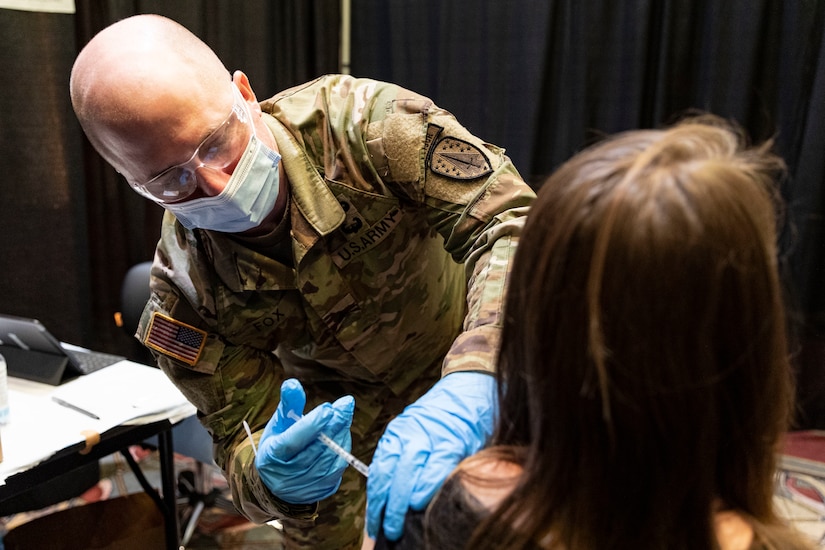
Since that time, 16 million vaccinations have been administered. At the peak of the effort, there were 35 locations across the U.S. where teams of service men and women — as many as 222 — worked to provide vaccinations.
Now, after much success, that effort has drawn almost completely to a close.
"As of today, we are supporting eight vaccination sites and expect to reduce that to five by the end of today," Pentagon Press Secretary John F. Kirby said. "We are proud of the support, of course, that our service members — both active duty and National Guard — have provided to combat this pandemic."
By Wednesday morning, he said, only five sites will remain open. Those sites are in New Jersey, Oklahoma, Oregon, Minnesota and Kentucky.
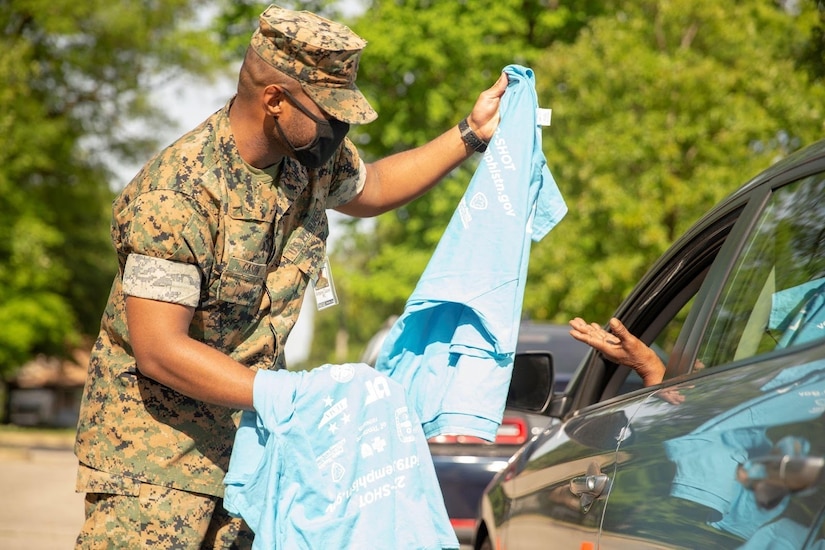
The Defense Department's fight against COVID-19 isn't limited to the U.S. Currently, DOD is also working to provide COVID-19 support to nations in South Asia, Kirby said.
"If you didn't see it over the weekend, Travis Air Force Base remains extremely busy supporting government efforts to provide emergency assistance to countries in South Asia," he said.
Travis Air Force Base in California is helping the U.S. Agency for International Development airlift much-needed medical supplies to help Bangladesh battle its latest COVID-19 surge, Kirby said.
"An Air Force C-17 flight departed late Friday from Travis for Dhaka, Bangladesh, carrying over 2 million pieces of personal protective equipment to protect thousands of health care workers in Bangladesh," Kirby said.
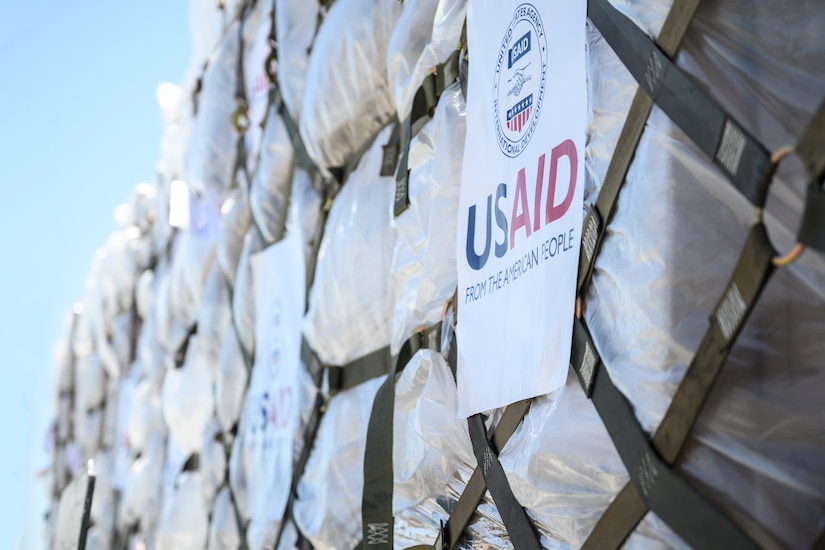
The U.S. military has also helped USAID provide assistance to other nations, including India, Nepal, Maldives, Pakistan and Sri Lanka.
The partnership between USAID and the DOD, he said, demonstrates the United States government's global response to ensure that life-saving assistance and supplies reach those who need it most.June 8, 2021 | BY David Vergun , DOD News
The $715 billion defense request is aligned to the National Security Strategy and the National Defense Strategy and is guided by DOD's priorities: defend the nation, take care of personnel and their families and succeed through alliances and partnerships, Kathleen H. Hicks told the Center for a New American Security.
Hicks said the budget provides investments to meet the challenges of China — which is a pacing threat — as well as Russia, Iran, North Korea and non-state actors.
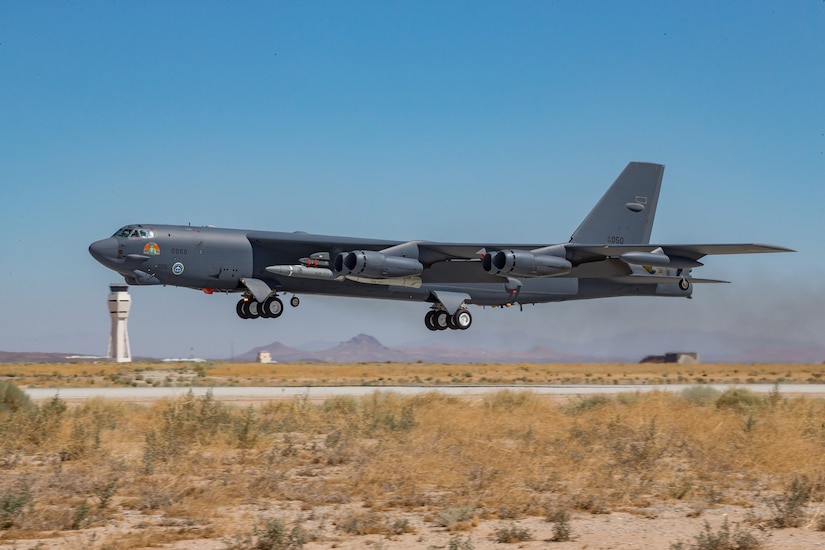
The budget also reflects some of the tough choices the department has had to make, including lessening reliance on vulnerable systems, she said.
Savings from divesting in those systems will be reallocated to fund research and development in enabling technologies like cyber, long-range fires, microelectronics, offensive and defensive hypersonic systems, artificial intelligence and quantum science, Hicks said.
This budget includes the largest ever research development test and evaluation request at $112 billion, which includes $14.7 billion for science and technology, she said.
Investments also focus on U.S. manufacturing and innovation, especially in underrepresented populations and with small businesses, Hicks said.

Investing in people is also high on the list of department priorities, she said. "We prioritize growing our talent by providing pay raises for both military and civilian personnel, and we seek to make investments in the workforce where the department has critical demands, like cyber. The FY22 request also looks to build an increasingly resilient force, one that recognizes and embraces its diversity as a strength."
Hicks said another investment in people includes providing funding for the military health system and $8.6 billion for military family support programs.
Other budget priorities include combating sexual assault and harassment, rooting out insider threats and extremism in the ranks, addressing climate change, building energy saving platforms and diverse power sources, and defeating COVID-19, she said.
June 8, 2021
Q: Your -- your arrival was perfectly-timed.
PRESS SECRETARY JOHN F. KIRBY: For?
Q: We have a discussion going on, and only you can answer, sir.
Q: No.
(CROSSTALK)
MR. KIRBY: That's a little frightening.
Q: No, no, no.
Q: We're trying to figure out how you would say "pacing challenge" in French, and apparently...
(CROSSTALK)
MR. KIRBY: It's not a -- first of all, it's not a pacing threat, Mike. We call it a "pacing challenge." Let's get the lexicon right. I've never said threat.
(CROSSTALK)
MR. KIRBY: It's not official unless I say it. I can't help you. I -- I -- I barely -- I barely do English, so...
(CROSSTALK)
MR. KIRBY: OK, good morning. Just a few things at the top.
Today, I think you saw, the Defense Department released our Strategic and Critical Materials 100-day Sector Review, as directed by Executive Order 14017, America's Supply Chains. This report will leverage insights from across the government to ensure we're managing supply chain risks, especially for the strategic and critical materials on which our economy and national security rely. This whole-of-government effort will help us develop and modernize our supply chains for the 21st century.
If you didn't see it over the weekend, Travis Air Force Base remains extremely busy supporting government efforts to provide emergency assistance to countries in South Asia -- South Asia. The U.S. Agency for International Development, USAID, airlifted urgent medical supplies to help Bangladesh battle its latest COVID-19 surge. Air Force C-17 flight departed late Friday from Travis for Dhaka, Bangladesh, carrying over two million pieces of personal protective equipment to protect thousands of healthcare workers in Bangladesh. And these flights, of course, as you know, build on our support to USAID's efforts to help India, Nepal, Maldives, Pakistan and Sri Lanka as they continue to battle surges of COVID-19 cases, and they further demonstrate the United States' whole-of-government global response to ensure lifesaving assistance reaches people who need it quickly.
Back on COVID, as I told you a few weeks ago, in coordination with FEMA and state and local officials, several DOD-supported community vaccine centers will be mission-complete or will begin reducing personnel as the sites reassess the size of the DOD vaccination support teams needed. So as of today, we are supporting eight vaccination sites, and expect to reduce that to five by the end of the -- of today as both -- as Ohio, Colorado and Louisiana conduct their final days of operations. We are proud of the support, of course, that our servicemembers, both active-duty and National Guard have provided to combat this pandemic, including administering over 16 million vaccines to the American public.
So again, as of today, the -- these eight sites, you've got five type I teams in Ohio, New Jersey, Colorado, Oklahoma and Oregon; three type II teams in Minnesota, Louisiana, Kentucky; a total right now, as of today, of 454 personnel. But again, by the end of the day we'll -- we'll be -- expect to be -- we'll expect to be down to those -- those five -- just five sites, so moving along.
And with that, I think we're ready for the questions. Lita?
Q: Hi. Thanks, John. One quick request -- I think this has been made in the past, but considering that CENTCOM is saying they're not going to provide percentages any longer on Afghanistan troop -- troop and equipment withdrawal, I was wondering if there's any progress on -- on getting us either DLA or some type of briefing on some of the things that can be discussed about… the withdrawal.
And my second -- my -- my question is has the Secretary had any discussions with Turkey about security at the airport in Afghanistan and -- and do you see negotiations progressing on that issue?
MR. KIRBY: Has he had discussions with who about that, Lita?
Q: The Turks?
MR. KIRBY: Oh, the Turks, I'm sorry, I couldn't hear you. So on your first question, I -- I recognize the desire for a more fulsome briefing, and we are working towards that, and as soon as I have something more specific to announce, I certainly will.
On your second question, I don't have any conversations with Turkish leaders to read out to you today but I can assure you that the Secretary's in touch with General McKenzie, as well as the -- General Milley about the future of the airport, the importance of security at the airport as -- as it relates to our ability to maintain a diplomatic presence in Afghanistan, which, of course, will be supported by a measure of security -- share -- security forces by the Department of Defense.
So yes, he's in discussions and consultations with -- with military leaders about the future. There has not been, as far as I know, any final decisions made about security at the airport, in terms of what that's going to look like, who's going to do it and -- and what the scope and scale of it's going to be, but I think you all heard from General McKenzie yesterday, recognizing that that is a -- an important component in terms of the kinds of decisions that we're going to have to make going forward. So no update but it is something that the Secretary is very engaged on.
Meghann?
Q: Do you have in your notes there how many total vaccines the FEMA sites that were manned by troops were able to distribute?
MR. KIRBY: I thought 16 million...
(CROSSTALK)
... yeah, but ...
(CROSSTALK)
... 16 million but let me just -- let me just check here, Meghann. Yeah, here we go. No - doesn't have it in there. My opening comments -- I think that's -- I think that's accurate, it's 16 million into American arms. Yeah, over 16 million vaccines to the American public. Yeah. Mm-hm. Mike?
Q: Yeah, as a -- you know, staying on that topic, in its -- at the height of the pandemic, how many of these vaccination sites did -- was DOD supporting?
MR. KIRBY: It was more than 30 -- it was more than 30. I think the top number, Mike, was 31 but we'll check that to make sure. I'm almost positive that we got up to 31 total teams. Oh, they weren't all Type 1, I mean, they were various sizes ...
Q: 30, down to five by the end of ...
MR. KIRBY: We went from 31 and now we're down to five today -- we'll be five today, yeah -- yeah. I'm -- let me just triple check the number but I'm almost positive it was 31. OK, Laura Seligman?
Q: Hey, thanks for doing this. I wanted to ask you about the Pacific Deterrence Initiative. Why -- can you tell me why the OSD budget request did not fund PACOM's top priorities in the list that they sent to Congress earlier this year? My understanding is it funded destroyers and F-35s instead of the missile defense priorities that Admiral Davidson wanted.
MR. KIRBY: We -- we've -- we've -- I think we've -- we've briefed the budget pretty clearly, Laura. I don't have a lot more detail to offer you today, and you've heard the Secretary speak about this. Our funding request includes $5.1 billion for Pacific Deterrence Initiative, so it is funded in the budget, and the Secretary is -- is confident and comfortable that that budget request for the Pacific Deterrence Initiative dealt -- help -- will help give us the right mix of capabilities that we need most for our security commitments in the Indopacific region.
Q: So are you saying that the PACOM Commander is not the expert in what he needs in his region and that the -- the -- that OSD knows better? ‘Cause that sounds like kind of what this budget request is reflecting.
MR. KIRBY: The budget request is the President's budget request. The Secretary is comfortable that it gives us the right mix of capabilities that we need most to defend this nation. And -- and he certainly appreciates and respects the input that's provided by all of the combatant commanders but he's very comfortable in this budget request and -- and what -- and -- and what it helps us fund for the Indopacific region.
And I would add that there are additional funding requests in there beyond PDI that get at the sorts of capabilities that we know we need to meet our security commitments in that part of the world -- hypersonics, 5G, microelectronics, missile defense, nuclear modernization, you know, the -- the -- the purchases of more combatant ships.
So there's -- there's a lot in there that -- that goes beyond just PDI that the Secretary believes are -- are -- are, again, the right mix of capabilities for the obligations we have in the Indopacific region.
Yes, sir -- Tom?
Q: Hi, John, thanks, good morning. Two unrelated questions. One, last week, during Mr. Gantz's visit here, there was support to refund the Iron Dome program in Israel. Where does that money come from?
And -- and my second question is a follow up to the taken question response last night about Greenland being in Europe Com. Is that window closed now? I know that Israel moved from European Command to Central Command. Is that two-year review that does, you know, what goes and what -- is that done?
MR. KIRBY: I don't believe it is done, Tom, but let me get you a better answer on that. I don't believe that a -- that that has been completed.
On the replenishment requests, again, this was just an -- this was an initial discussion with Minister Gantz about the -- about their needs. The Secretary made it clear that -- that the President has been determined to help them replenish and now comes the work of the -- the sourcing of it.
So we don't have an answer for you right now as to, you know, where the money is going to come from because frankly we haven't actually -- just like we do for any request for assistance, we do the analysis here, we -- we take a look at it, we review it, we determine validity and then we try to source it.
So I don't have specific sourcing solutions to talk to you today ...
Q: ... it Defense Department money?
MR. KIRBY: I -- again, I don't have -- I don't have specific sourcing solutions to talk to you today, so I -I'd -- I'd -- I'd rather not make a definitive comment on that until we've had a chance to do the -- the complete analysis.
Q: OK, thank you.
MR. KIRBY: Yeah. Jeff Schogol?
Q: Thank you very much. The civilian contractors who keep the Afghan helicopters and planes flying are going to depart Afghanistan with the rest of the foreign troops. I wanted to see what is the plan to make sure the Afghan Air Force remains viable without these maintainers? Because I'm seeing media reports that make it appear as though once the drawdown is complete, most Afghan aircraft will be grounded for lack of maintenance.
MR. KIRBY: Jeff, as we've talked about before, and -- and I think you heard General McKenzie actually speak to this yesterday. I mean, he and his staff are -- are working through what the follow-on contractual arrangements will be made to continue to support things like aircraft maintenance for the Afghan National Security Forces. Those -- all -- all those decisions have not been completed, but rest assured we're working hard on that. And -- and again, when we have, you know, more discrete solutions to present, we'll do that. But you've heard the secretary speak to this -- that our support for the Afghan National Defense and Security Forces is going to be largely in the financial realm, and that there will be some over-the-horizon logistical support for things like aviation maintenance. But again, we just haven't locked all the details down right now.
Q: The clock is ticking, and I understand -- you know that -- and there are no agreements yet for an over-the-horizon force in neighboring countries. And as the U.S. military learned during the aviation crisis, a lack of maintainers means that planes don't fly. So I'm just trying to see, is there anything concrete that the Defense Department can say about how it intends to keep the Afghan Air Force in the fight after the withdrawal?
MR. KIRBY: Jeff, we're mindful of the -- the need for good aircraft maintenance, and we're certainly mindful of -- of how important the -- the Afghan Air Force and Special Missions Wing are to their self-defense capabilities. Again, I can assure you we're working on this very, very hard, and again, when we have more detail to provide, we certainly will.
Sylvie?
Q: I would like to go back to the airport, the question of the airport. Is it something that will be decided during the NATO summit in the next few days, or it's something that will be decided later?
MR. KIRBY: I -- I -- I don't -- I don't have anything specific on the NATO summit agenda to -- to point to with respect to this. There are ongoing discussions, and -- and -- and certainly, that -- that we expect will -- will have to include discussions with Turkey on what their intentions are with respect to security at the airport. But I don't want to get ahead of process here and predict to you a -- a -- a date certain where a decision will be made, or -- or how that decision will be transmitted. But we -- we are in active discussions right now, and -- and again, when -- when we have better clarity, it -- it'll be easier to -- to speak to what that means for our diplomatic footprint and the security footprint that -- that we at DOD are going to need -- are going to -- are going to have to provide to support the -- the -- the embassy compound in Afghanistan.
Q: So the secretary is going to attend the summit, eh? The NATO summit.
MR. KIRBY: He is. He is.
OK, Sam LaGrone?
Q: Hey, John. I was just wondering if we could get a -- a status update on what's going on with the COCOM reviews, if y'all had an anticipated date, and just -- because if you look at the budget, it -- it -- it -- there's no five-year future defense plan. We haven't seen a shipbuilding plan yet. This all seems to be more or less a -- a placeholder in -- in -- in head of the -- another strategic look here, so if you can give us an update in terms of where the COCOMs are going to be in terms of this review, and kind of the next strategic guidance and when we could expect that, that'd be great. Thanks.
MR. KIRBY: Yes, and I think you're talking about the Global Posture Review, and -- and that is ongoing, and as we said earlier in the spring, we expect that to be able to -- to wrap-up here this summer, probably more towards late summer. But -- but that work is ongoing and obviously we're doing it in consultation with not only the services but with the combatant commands. So work -- work progresses.
I don't have a specific update for you. In other words, I don't have, like, a date certain for when the work's going to be done and the secretary has a chance to review it. But that team is -- is hard at work right now.
And, Mike - , you asked me about number of teams and the number at -- at -- at its height was 35. So I got close, but I was wrong. It's 35.
Thank you, Chris, for doing that rather than having to do that as a taken question. I appreciate that.
Okay, yes, ma'am.
Q: Hi. Thank you, John. Sandra Erwin with SpaceNews. I have a question about the strategic materials review. Who's -- what office in DOD is doing that, specifically overseeing that review?
MR. KIRBY: Let me get back to you. So I know the -- the deputy secretary was over at the White House today for this event, but I'll get back to you on if there's a specific audience -- or office.
Q: And another question I had, the -- the -- the administration nominated Michael Brown to be under secretary of defense for acquisition but we haven't seen him scheduled for any confirmation hearings. So can you tell us what the status of this nomination is? Is that still moving forward?
MR. KIRBY: As far as I know, the -- the -- yes, the nomination is still moving forward. I would refer you to the Senate Armed Services Committee for -- for the, you know, scheduling of -- of hearings. But I'm not aware of any change at this time.
Q: Thank you.
Q: Hey, John, sorry to interrupt. But to follow on Sandra's first question, last year -- and I realize you guys weren't here last year -- General Milley had talked about a similar panel or a group --
MR. KIRBY: Yes.
Q: -- within the Pentagon that do strategic review. Is this going to be a continuation of that to the best of your knowledge or is that --
MR. KIRBY: Strategic review of supply chain?
Q: Yes.
MR. KIRBY: I don't know.
Q: Okay.
MR. KIRBY: I don't know. I wasn't aware of that. And I -- you know, again I'll ask the question because it's a good one. It may be that it's not just one office here but -- you know, but a team effort across because it does affect so many different parts of our enterprise from acquisition to research development. So there's a lot there. But it's a fair question, so I'll get back to you on that.
Yes, Pierre?
Q: Recently, State Department was a little bit vocal expressing their concern about what's happening in Yemen, especially the Houthi continuous attacks trying to take Marib. My question is that would the Pentagon be ready, the military will be ready to go back, give some support to the coalition or directly to make sure that a human disaster will not happen in this part of the world?
MR. KIRBY: Well, you know, we don't talk about potential future operations, Pierre. But I'm not aware of any pending change in our posture with respect to support to the coalition.
As you know, President Biden withdrew the support that we had been lending to the Saudi-led coalition for their offensive operations inside Yemen. That has not changed.
Okay, thanks.
June 8, 2021
Today, the Defense Department released the Strategic and Critical Materials 100-day Sector Review, as directed by Executive Order 14017. Secretary of Defense Lloyd J. Austin III released the following statement:
“Strategic and critical materials are vital to our national defense and economic prosperity, enabling the United States to develop and sustain emerging technologies. They also improve our warfighting capability, support family-sustaining jobs, and strengthen our alliances and partnerships. Though there is more work to be done, the Department of Defense remains committed to a whole-of-government approach to preserve our access to strategic and critical materials. This is important not only for our national defense, but to ensure our national economic well-being.”
The department defines strategic and critical minerals as those that support military and essential civilian industry; and are not found or produced in the United States in quantities to meet our needs. Like many other supply chains, much of the strategic and critical materials sector has moved offshore. Some of this reflects normal, comparative advantage or quirks of geologic fate. But, in some cases, other countries have deliberately put a hand on the scale to capture market-share, and our industry has followed close behind — in a global race to the bottom.
The concentration of global supply chains for strategic and critical materials in China creates risk of disruption and of politicized trade practices, including the use of forced labor. Though DoD has requirements for strategic and critical materials, the civilian economy would bear the brunt of the harm from a supply disruption event.
Overall, the recommendations presented by DoD are intended to attack the supply and demand side of the strategic and critical materials question at the same time.
A soldier participates in a rapid response crisis training exercise in Kenya, June 2, 2021. The training demonstrated how U.S. forces can rapidly respond to deter the threat posed by violent extremist organizations.
Sailors compete in a fire hose tug-of-war during a Damage Control Olympics event aboard the USS Paul Ignatius in the Atlantic Ocean, June 5, 2021.
A soldier participates in a rapid response crisis training exercise in Kenya, June 2, 2021. The training demonstrates how U.S. forces can rapidly respond to deter the threat posed by violent extremist organizations.
A sailor fast-ropes from a Navy MH-60S helicopter aboard the USS Shiloh during a refueling in the Philippine Sea, June 4, 2021.
June 8, 2021
|
BY David Vergun
, DOD News
Born in 1917 in Waubay, South Dakota, Woodrow "Woody" Wilson Keeble was a full-blooded member of the Sisseton Wahpeton Oyate of the Lake Traverse Reservation, which straddles North and South Dakota.
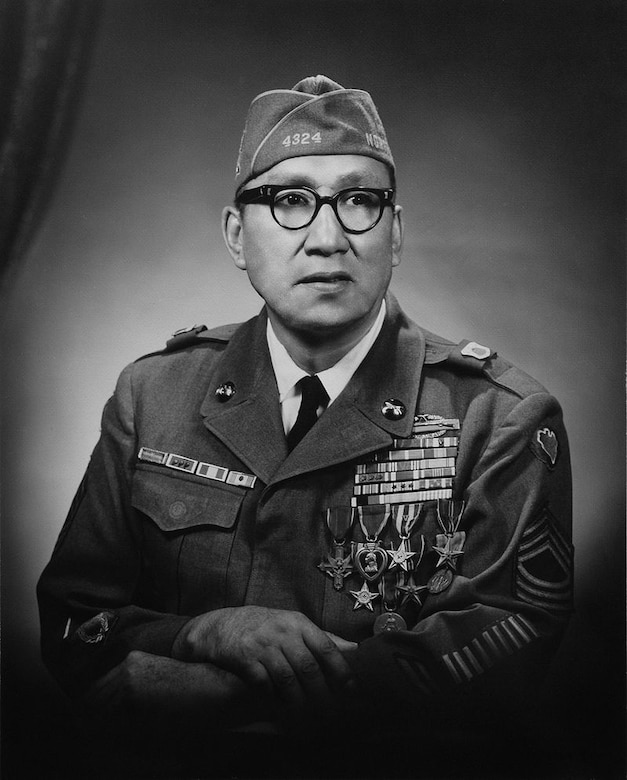
A naturally athletic young man, Keeble became an accomplished baseball player. He was so good that the Chicago White Sox recruited him.
However, as fate would have it, World War II broke out, and he enlisted in the Army National Guard and served from 1941 to 1946—the duration of the war and then some.
He served with I Company, North Dakota 164th Infantry Regiment. The 164th landed on Guadalcanal in the South Pacific on Oct. 13, 1942, to backfill for the First Marine Division, which had suffered heavy casualties while clearing the island of Japanese.
Keeble's regiment was the first Army unit to conduct an offensive operation against the enemy in any theater during that war. The division distinguished itself on Guadalcanal, crushing a major Japanese offensive that lasted Oct. 24-27, 1942.
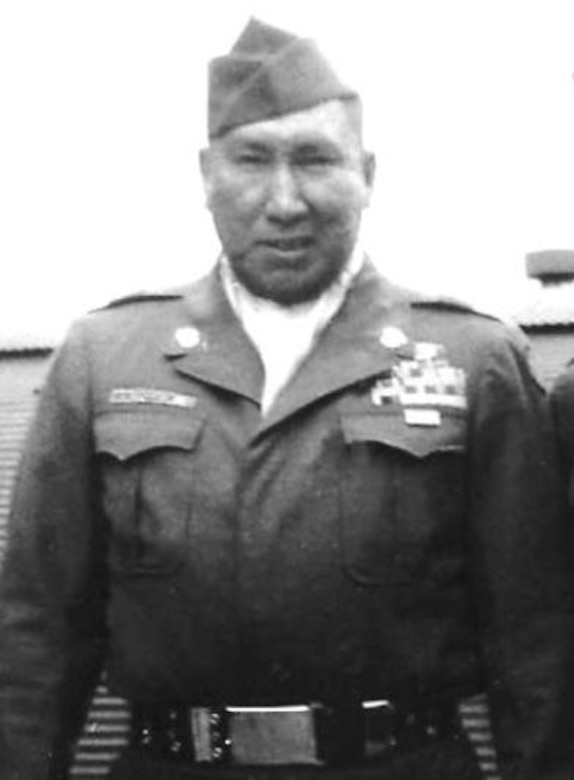
During the offensive, Keeble's reputation for bravery and skill grew, as he put his Browning automatic rifle to good effect and used his strong and accurate pitching arm to hurl grenades with deadly accuracy. James Fenelon, a member of the Standing Rock Sioux Tribe of North and South Dakota who fought with Keeble on Guadalcanal, once remarked, "The safest place to be was right next to Woody."
Later, Keeble and his regiment participated in combat operations on the Southwest Pacific islands of Bougainville, Leyte, Cebu and Mindanao. Following the Japanese surrender in 1945, his regiment took part in the occupation of the Yokohama region of Japan.

Keeble was honorably discharged from the Army on April 11, 1946. He returned to the reservation, having decided to forego a baseball career.
When the 164th Infantry Regiment was reactivated on Jan. 16, 1951, during the Korean War, Keeble once again answered the call to duty. He served in combat in Korea from 1951 to 1952, attaining the rank of master sergeant.
In October 1951, Keeble was wounded four times — on Oct. 15, 17, 18 and 20. For his bravery on Oct. 18, he was awarded a Silver Star Medal. However, his heroism on Oct. 20 made Keeble an even greater legend.
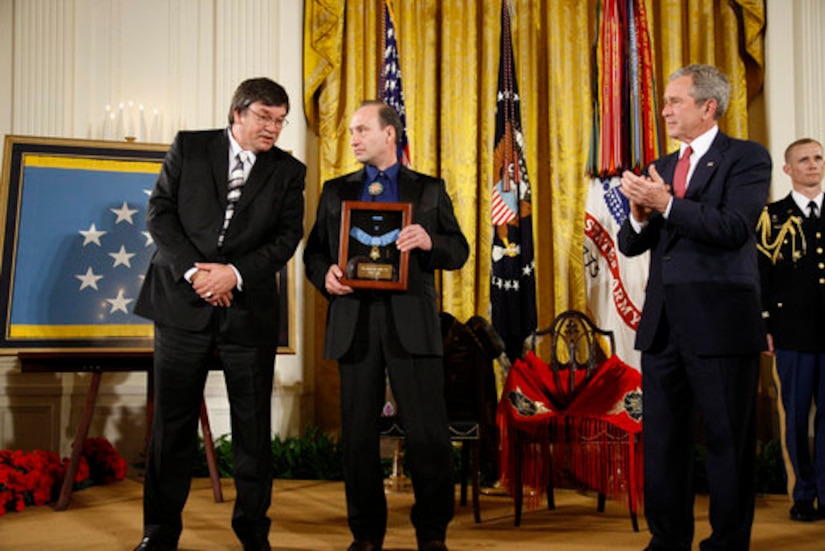
On that day, Keeble single-handedly destroyed three enemy machine-gun bunkers and killed an additional seven enemy soldiers in nearby trenches. For those actions, he was awarded the Distinguished Service Cross, the Army's second highest award for valor.
Keeble was removed from frontline duty to recover from his wounds and was discharged on Aug. 26, 1952. He returned to the reservation and lived there until his death on Jan. 28, 1982.
But that's not the end of his story. His actions on Oct. 20, 1951, were later reviewed by the military and it was decided that his Distinguished Service Cross should be upgraded to the Medal of Honor. President George W. Bush posthumously awarded him the medal on March 3, 2008. Keeble's stepson, Russell Hawkins, accepted the Medal of Honor on his behalf.